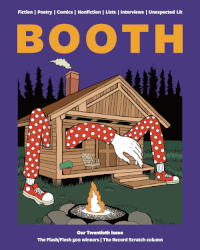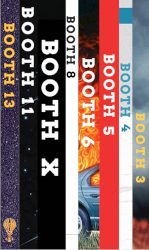It seems like you later learned to embrace that sort of transformation, though. First with Paul French, and later when Neal Bowers wrote a book called Words for the Taking about his search for someone who had plagiarized a number of his poems—you then started publishing poems under the name Neal Bowers, essentially donating to his oeuvre instead of stealing from it.
That’s not entirely true, although that is what I told everyone at the time. I’d been planning on doing that, but then my uncle called me one afternoon—I’d just started teaching at Iowa State—and told me my cousin Maddie had written these really lovely poems. I needed to read them, he said. So I said, well, okay, send me some. I wasn’t exactly thrilled. I knew he was looking for me to validate her poems, to tell him they showed all of this promise I already knew they wouldn’t.
But when the poems arrived I was blown away. Not by all of them—most of them were your average eleven-year-old’s poetry. A haiku about her dog, a poem about Halloween, an acrostic about Lake Michigan. But three or four of them were, I thought, some of the most brilliant poems I’d ever read. Especially by a middle schooler.
Of course, I knew nobody was going to publish a poem by sixth grader Maddie Cook, no matter how good it was. As long as her name was attached to them, they were entirely unpublishable. But I was interested in the merits of the poetry itself. So I sent the poems off to a couple magazines with Neal’s name attached to them. I thought, if Neal had written them, would they want them? It turns out that they did.
What did your uncle say when he found out?
He didn’t. I never told him they were published—I think he would have been upset that I had published them under Neal’s name. So I just called him and said, “Look, the poems are okay, but pretty good for an eleven-year-old. Tell her to keep at it.”
Have you told anyone this before? Publicly, I mean?
No, but my uncle doesn’t read literary magazines, so it doesn’t matter. And anyway, I don’t consider this “publicly.” Most writers don’t read author interviews, and even if they do they’re just sort of skimming. I could say anything here I wanted to and it wouldn’t matter.
I know you’ve written a number of “alter ego” fictions since—Dean Strickland, Ts’ui Pên.
I’ve begun and abandoned countless alter egos. I’m often worried my unfinished selves will come back for me, for some form of haunting, like in Six Characters in Search of an Author.
Are you the only writer working in the “alter ego” genre, as far as you know?
No. I have a number of contemporaries. And of course it’s a very old genre—The Book of Incandescent Light, for example, was written in the 17th century.
Have you heard of The Book of Incandescent Light? It was published by an Irish writer named Lord Wilmore. Several years after it was written, however, Lord Wilmore announced he was merely a nom de plume—he had agreed to be used as such by another writer, Edmund Busconi. So began the trail of nom de plumes—all actual people—each of whom came out as the “author,” one after another—Busconi, then Zaccone, then Picaud, then Maquet, and so on—each of them outing the previously-supposed-to-be “author” as merely a human nom de plume. This went on into the 18th century—the trail of nom de plumes went eight or nine “authors” deep.
One of my favorite writers in the alter ego genre, though, is Sophie Calle. Calle once asked Paul Auster to invent a fictional character she would “attempt to resemble.” So Auster used her as the model for Maria Turner, a character in his novel Leviathan. Like Calle, Turner is an artist. But the art that Turner makes in the novel is fictional—it’s not based on anything Calle had actually made. One piece was a series of color-coordinated meals, for example—everything on the dinner plate was blue; the next meal, everything on the dinner plate was violet. After the novel was published, Calle then actually created the works of art that had been attributed to her “fictional” self in Auster’s novel.
I’ve read that since your mid-twenties you’ve been at work on a project called The Numberless. When, if ever, will you publish it?
I already have. I self-published a hundred copies of The Numberless, and those are the only copies of it I’ll ever allow to be printed. I’d personally value a copy of The Numberless at around $5, but, like any rarity, it’s now selling for far more than it’s actually worth. Earlier this winter an unsigned copy of The Numberless sold on eBay for about $870. I myself have three signed copies, which means I own about $4,200 of The Numberless. My copies aren’t for sale, though.
In another interview you mentioned The Numberless was an “interactive” story.
Did you ever play Dungeons & Dragons? As a kid I was obsessed with all games—my grandmother taught me mahjong, cribbage, chess, and of course we played the newer games like LIFE and Trouble—but with Dungeons & Dragons it was an obsession far beyond any other.
What was so compelling about it was that it was this narrative game. Other games had this vague sort of narrative attached to them: in Clue, you know, each piece is a named character, and you’re trying to solve the murder of Mr. Boddy; in The Settlers of Catan you’re supposed to be building these colonies on the island of Catan. But in Dungeons & Dragons, it’s not just some vague narrative—the game is about the narrative. The Numberless is the opposite of that. It’s a game-type narrative. It’s interactive, but it’s still primarily a story.
Did you publish it under your own name?
No, that one I published under the name Ts’ui Pên.
I’ve heard you publish your genre novels under a variety of nom de plumes.
Actually, most of my genre work I publish under the same name. My romance novels, urban fantasy, steampunk westerns, those I publish under the name Mark Clements.
When I was working on my horror novel, though, Kaonashi, my editor wrote me an email saying she’d discovered “there’s someone else already writing abysmal horror novels under the name Mark Clements.” So I published Kaonashi under the name Andre Huett instead. Clements and Huett are the only ones I’ve used for genre work, though.
Why “Mark Clements”?
I wanted an anagram for Clark Kent, but even using the “I, Rearrangement Servant,” the best anagram I could get was Karl Tenck, and I thought Tenck sounded made-up. So I started adding letters, and rearranging letters, and I ended up with Mark Clements.
You’ve written a number of essays on the myth of the superhero. I’ve read that Thomas Pynchon has said he first got you into comics while you two were rooming together in Brooklyn.
No, I was reading comics before that. When I was growing up my uncle owned a shop that sold comics, baseball cards, and Scottish memorabilia. It was attached to his house. Every few weeks I would go over there to spend the night; we’d watch Star Wars, Citizen Kane, The Searchers, eat popsicles from the convenience store across the street. Then the next day I’d help him run his shop. He always paid me in comics. He didn’t have to—I was eight years old and thought that just being in his shop was the greatest thing in the world. But he paid me anyway, one or two comics a day. So I ended up with a lot of Batman comics, Superman, the Fantastic Four.
My uncle sold a lot of foreign comics though too—through him I ended up with almost every issue of Métal Hurlant, most of Tintin, a number of Tezuka’s books. He also carried a lot of the underground comics that were just starting to emerge at that time—Spiegelman in Real Pulp, Pekar in American Splendor.
Speaking of Pynchon, he’s also worked in the alter ego genre, but on the nonfictional side of things. Pynchon claims that in his early thirties he was abducted by aliens—aliens who then replaced him with a changeling, a fake human who assumed the name Thomas Pynchon and then published Pynchon’s first novel, V. Meanwhile, it was Pynchon’s experience onboard the alien spacecraft that inspired most of the material in his second novel, The Crying of Lot 49, which Pynchon published once he’d been returned and had reassumed his identity.
I’ve heard that Pynchon had published an essay about his abduction in Harper’s, but I haven’t actually read it.
Changelings are in some of our oldest stories—before aliens, it was fairies that would use them. Fairies would abduct a newborn baby, then replace it with an imposter. The way to prevent this was to name the baby—once a baby had been named, the fairies couldn’t steal it. It was only the nameless babies they had the power to steal.
The name of this syndrome is Capgras—it’s a psychological disorder where one is actually prone to these delusions. You become convinced that someone close to you has been replaced by an identical imposter.
A related syndrome is Cotard syndrome—it’s a psychological disorder where one becomes convinced that one has died, or sometimes, rather, that one does not exist.
You’ve called Neil Gaiman’s The Sandman “a formal initiation of the superhero pantheon into the realm of world mythology.” In what sense are superheroes a pantheon?
In the sense that they were written in the same way as historical mythologies—by a community of storytellers, over a period of generations—and that these sometimes immortal, always superhuman gods share a fictional universe and play a role in each other’s stories. We have other American mythologies—our folktales, our urban legends—but those are isolated myths, trapped in their own fictional universes. They can’t intermingle like the gods of an actual pantheon.
I was glad to see our American pantheon recognized in that way in Gaiman’s work. I love superheroes and supervillains, the mythology of them—our gods and demigods as masked vigilantes, ruining our cities with their warring.



